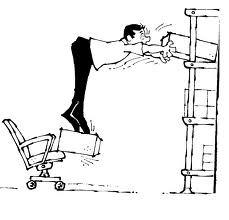Dealing With An Unsafe Workplace...
The first step to protecting yourself at work is being able to recognize hazards in your work and environment.
Physical Hazards...
Physical hazards are very common in most workplace. They are easy to spot but surprisingly often overlooked. They can cause injury, illness and even death.
Types of Physical Hazards include:
Physical Hazards...
Physical hazards are very common in most workplace. They are easy to spot but surprisingly often overlooked. They can cause injury, illness and even death.
Types of Physical Hazards include:
- Electrical hazards
- Unguarded machinery
- Constant loud noise
- High exposure to sunlight/ultraviolet rays, heat or cold
- Working from heights or any raised area
- Working with mobile equipment
Chemical Hazards...
Some chemicals are safer than others, but for workers who are sensitive to chemicals, even common solutions can cause illnesses such as skin irritation and breathing problems.
Types of Chemical Hazards to look out for include:
- Cleaning products, paints, acids and especially chemicals in an unlabeled container.
- Gases like acetylene,propane, carbon monoxide and helium.
- Flammable materials like gasoline,solvents and other explosive chemicals.
Musculoskeletal disorder Hazards...
These hazards are workplace conditions that pose the risk of injury to your musculoskeletal system. They are tough to spot because you don't always immediately notice the strain you're putting on your body. Short-term exposure may result in sore muscles, but long-term exposure can result in more serious injuries.
Types of Musculoskeletal disorder Hazards to look out for includes:
- Poor Lightening
- Improperly adjusted workstations and chairs
- Frequent lifting
- Awkward Postures
- Awkward movements, especially if they are repetitive an d forceful
Biological Hazards...
Biological Hazards are typically found when working with animals, people or infectious plant materials.
Types of Biological Hazards to look out for includes:
- Blood or other blood fluids
- Fungi
- Bacteria/ Viruses
- Moulds
- Insect bites
The 3 R's to Safety...
1. Recognize the Hazards...
You know that feeling you sometimes get in the pit of your stomach when something doesn't seem quite right? Learn to follow it! While some hazards are easy to spot,they are many hidden hazards that fly under the radar,such as faulty machinery or equipment. You should report all potential hazards as soon as you sense that something is wrong.
2.Report the Hazards...
Reporting a workplace hazard is the only way the problem can get fixed. After all, your boss isn't a mind reader. How can something get fixed if he/she doesn't even know about it? By reporting a hazard you'll not only be protecting yourself, you'll also be protecting your co-workers.
3.Remove or Resolve the Hazard...
Once you report a hazard, it's up to your boss to ensure that the problem gets solved. This can include everything from adding a protective metal guard- to the installation of proper ventilation- it varies from situation to situation. If the problem isn't properly addressed, you have the right to refuse to work.
We should constantly strive to achieve a goal of zero incidences, with no lost time or reportable injuries, no environmental incidents or property damage and the smallest ''environmental footprint'' feasible.
IF IT AIN'T SAFE, DON'T DO IT...
Living Healthy..



Comments
Post a Comment